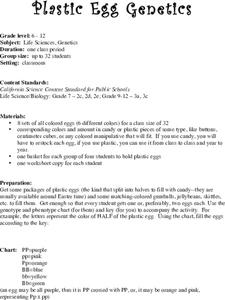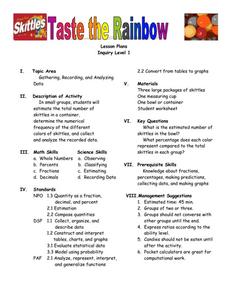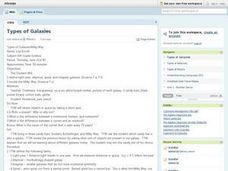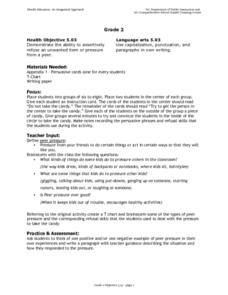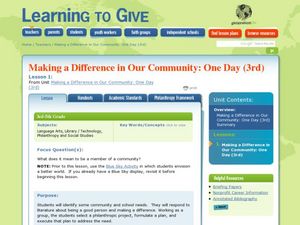Curated OER
Plastic Egg Genetics
Students are introduced to the concepts of genetic dominance, recessiveness, related terms, Punnett Squares, etc.
Curated OER
Circulatory System Design
Students identify the different parts of the circulatory system and their function. They work together to create their own model of the system and use it to determine the rate of blood flow. They answer questions related to their model.
Curated OER
Taste the Rainbow
Middle schoolers practice estimating and graphing by utilizing Skittles. In this statistics lesson, students complete worksheets based on the likelihood of a certain color of skittle coming out of the bag. Middle schoolers...
Curated OER
Radioactive Decay: A Sweet Simulation of a Half-life
High schoolers demonstrate rates of decay of unstable nuclei can be measured. They understand ratios and multiplication of fractions. They simulate radioactive decay. They read about the accomplishments of scientists.
Curated OER
Synectics - creative metaphors technique
Students create new ways of thinking about old things. They may use a modified approach to make unfamiliar material familiar (after teacher provides brief introductory materials, for example).
Curated OER
Types of Galaxies
Eighth graders take a quiz to review the different objects in space. As a class, they define terms related to galaxies. In groups, they make a model of the Milky Way galaxy using materials provided to them by their teacher. To end the...
Curated OER
Multiplying Polynomials - FOIL
Students participate in an activity to demonstrate the distributive property. They take notes as they observe different methods of FOIL. Afterward, students work on their own, and in groups to determine which method to use and complete...
Curated OER
Probability
Fourth graders perform probability experiments. In this math lesson, 4th graders complete a penny toss to evaluate and graph the combinations of outcomes. In a second activity, students draw M&Ms out of a bag and graph results. In a...
Curated OER
Local Organism Sort
Students determine what characteristics are useful in classifying items. In this sorting organisms instructional activity students create and explain a classification scheme using familiar organisms.
Curated OER
Health Education: Peer Pressure
Second graders examine peer pressure. In this health lesson plan, 2nd graders demonstrate the ability to assertively refuse an unwanted item or pressure from a peer.
Curated OER
Making a Difference in Our Community
Students reflect on the needs of the community and of the school. In this philanthropy lesson, students work in pairs to answer the questions, "Can kids make a difference?" Students understand the importance of making a difference by...
Curated OER
Decomposition vs. Synthesis Reaction
Students define the term chemical reaction, identify the reactants and products in a chemical reaction, distinguish between decomposition and synthesis reactions and construct reactions using food items.
Curated OER
M&M Math
Students plan and make the M&M cookies, tally M&M's by color while eating cookie, and completing worksheet using math skills.
Curated OER
Gingerbread Houses
Students are read different books about the holidays and gingerbread houses. They review a planning sheet on how to build their own gingerbread house. They must follow the steps in order and share their house with their classmates.
Curated OER
First Day of School: I'll Get to Know You
Students participate in a letter matching game that pairs students so that they can introduce a new friend. They listen to the Shel Silverstein book, The Giving Tree and write a letter to the class telling them what they will give to the...
Curated OER
Lord of the Flies Introduction
Twelfth graders, as an introduction to a unit on The Lord of the Flies, participate in an activity in which they demonstrate how good people can do things that they know are wrong. They discuss peer pressure and "why good people do bad...
Curated OER
Mapping Data Made Manageable
Learners explore how to select unbiased random samples as they choose report data to include on maps. They propose methods for choosing random numbers and discuss their advantages and disadvantages. They consider bias in science.
Curated OER
Pretty Patterns
Students discuss shape and number patterns and play a game practicing completing patterns. Then they rotate through five workstations that reinforce the concept of patterning.
Curated OER
Flotation
Pupils examine how one of the ways the mining companies extract coal is through the flotation method where air bubbles float coal particles to the top of a solution. The coal is scooped off and separated. They participate in the "Popcorn...
Curated OER
Kitchen Chemistry
Fifth graders examine both physical and chemical changes, and how to identify the difference between the two. They observe the changes that occur in butter when it is exposed to heat and cold, heat energy. In their notebooks, they write...
Curated OER
Mechanical Properties of Chocolate: How Hard is your Chocolate?
Pupils calculate, measure and identify the hardness of various chocolate bars. They determine the hardness of the chocolate bar using quantitative data. Students make observations of the hardness of chocolate while dropping the indenter...
Curated OER
Social Studies Lesson: Apartheid
Students examine the Apartheid system of South Africa through a role-play activity. The role-play activity ends with a class discussion on how the events affected each individual. A class discussion continues after reading an article...
Curated OER
Electrophoresis Analogy
High schoolers participate in a simulation of electrophoresis separation of DNA fragments. They link arms to form DNA fragments with each student representing a nucleotide. As they move through an obstacle course they discover how...
Other popular searches
- Halloween Candy
- Candy Sorting
- Charts and Graphs Candy
- Candy Bar
- Candy Math
- Candy Dichotomous Key
- Valentine Candy
- Candy Wrapper Spreadsheet
- Candy Canes
- Rock Candy
- Candy Hearts
- Candy Graph
